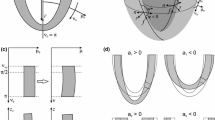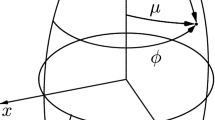Abstract
A comprehensive numerical model, based on the finite-element method, for the continuous simulation of the complete cardiac cycle is presented. The model uses real, measuredin vivo, three-dimensional geometry of the ventricle, and accounts for the anisotropy of the ventricular wall, the large deformations it undergoes during the cardiac cycle, the material nonlinearity of the myocardium and its mechanical activation. The simulation process is carried out incrementally while adjusting the mechanical activation for each increment so as to produce the same change in cavity volume as that measured experimentally. A detailed analysis of a complete cycle of the canine heart is presented in Part 2 of the paper.
Similar content being viewed by others
References
Arts, T., Reneman, R. S. andVeenstra, P. C. (1979) A model of the mechanics of the left ventricle.Ann. Biomed. Eng.,7, 299–318.
Capello, A., Comincioli, V., Minelli, R., Reggioni, C. andRicciardi, L. (1981) Study and parameters identification of a rheological model for excised quiescent cardiac muscle.J. Biomech.,14, 1–11.
Demer, L. L. andYin, F. C. P. (1983) Passive biaxial mechanical properties of isolated canine myocardium.J. Physiol.,339, 615–630.
Feit, T. S. (1979) Diastolic pressure-volume relation and distribution of pressure and fiber extension across the wall of a model left ventricle.Ann. Biomed. Eng.,28, 143–166.
Greenbaum, R. A., Ho, S. V., Gibson, D. G., Becker, A. andAnderson, R. H. (1981) Left ventricular fiber architecture in man.Br. Heart J.,45, 248–263.
Heethaar, R. M., Pao, Y. C. andRitman, E. L. (1977) Computer aspects of three-dimensional finite element analysis of stresses and strains in the intact heart.Comput. Biomed. Res.,10, 271–285.
Horowitz, A. (1984) A numerical model for the simulation of the mechanics of the left ventricle. M.Sc. thesis, Technion-Israel Institute of Technology, Haifa, Israel.
Horowitz, A., Perl, M., Ritman, E. andSideman, S. (1986) A comprehensive model for the simulation of left ventricle mechanics. Part 2. Implementation and results analysis.Med. & Biol. Eng. & Comput.,24, 150–156.
Kitabatake, A. andSuga, H. (1978) Diastolic stress-strain relation of nonexcised blood perfused canine papillary muscle.Am. J. Physiol.,234, 416–419.
Moskowitz, S. E., Lewis, B. S., Halon, D. A., Amar, R. andGotsman, M. S. (1978) Computer prediction of left ventricular compliance throughout diastole in normal patients.Eur. J. Cardiol.,7/Suppl., 121–132.
Pao, Y. C. (1980) Discussion: geometric modelling of the human left ventricle.J. Biomech. Eng. 102, 274–275.
Pao, Y. C., Nagendra, G. K., Padiyar, R. andRitman, E. L. (1980) Derivation of myocardial fiber stiffness equation based on theory of laminated composites.,102, 252–257.
Perl, M. andHorowitz, A. (1985) Limitations of finite element models of the left ventricle—review and future prospects, Proc. Henry Goldberg Workshop Simul. Imag. Cardiac Syst.,Sidem, S., andBeyar, R. (Eds.), Martinus Niihoff.
Pinto, J. G. andFung, Y. C. (1973) Mechanical properties of the heart muscle in the passive state.J. Biomech.,6, 597–616.
Ritman, E. L., Kinsey, J. H., Robb, R. A., Gilbert, B. K., Harris, L. D. andWood, E. H. (1980) Three-dimensional imaging of heart, lung and circulation.Science,210, 273–280.
Sonnenblick, E. H. (1980) The structural basis and importance of restoring forces and elastic recoil for the filling of the heart.Eur. Heart J.,1 Suppl., 107–110.
Streeter, D. D. andHanna, W. T. (1973) Engineering mechanics for successive states in canine left ventricular myocardium.Circ. Res.,33, 656–664.
Streeter, D. D. (1979) Gross morphology and fiber geometry of the heart. InHandbook of physiology, vol. 1 The heart.Berne, R. M., Sperelakis, N. andGeiger, S. R. (Eds.), Am. Phys. Soc., Bethesda, Section 2: The cardiovascular system, 61–112.
Tozeren, A. (1983) Static analysis of the left ventricle.J. Biomech. Eng.,105, 39–46.
Yettram, A. L. andVinson, C. A. (1979a) Geometric modelling of the human left ventricle.,101, 221–223.
Yettram, A. L. andVinson, C. A. (1979b) Orthotropic elastic moduli for left ventricular mechanical behaviour.Med. & Biol. Eng. & Comput.,17, 25–30.
Yettram, A. L., Vinson, C. A. andGibson, D. G. (1983) Effect of myocardial fiber architecture on the behavior of the human left ventricle in diastole.J. Biomed. Eng.,5, 321–328.
Author information
Authors and Affiliations
Rights and permissions
About this article
Cite this article
Perl, M., Horowitz, A. & Sideman, S. Comprehensive model for the simulation of left ventricle mechanics. Med. Biol. Eng. Comput. 24, 145–149 (1986). https://doi.org/10.1007/BF02443927
Received:
Accepted:
Issue Date:
DOI: https://doi.org/10.1007/BF02443927




